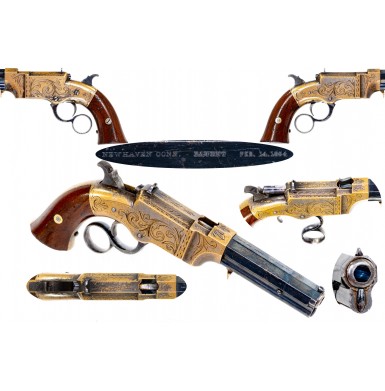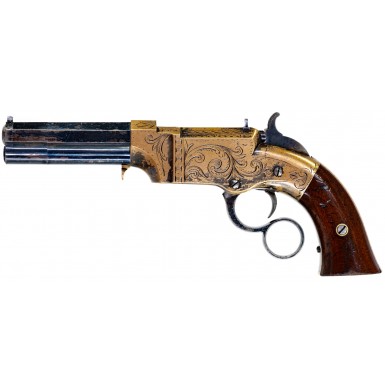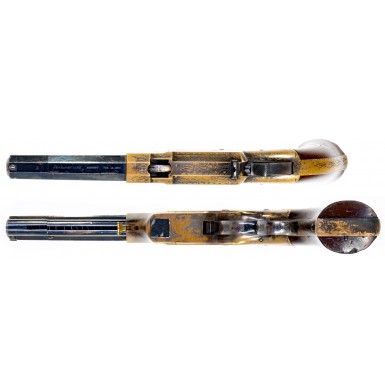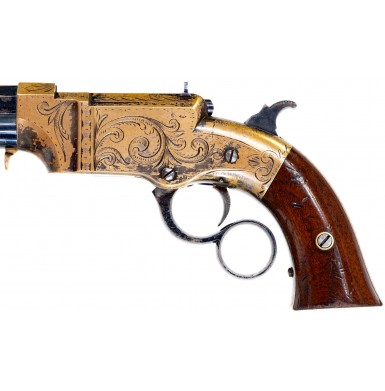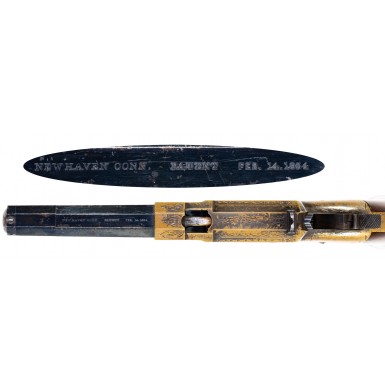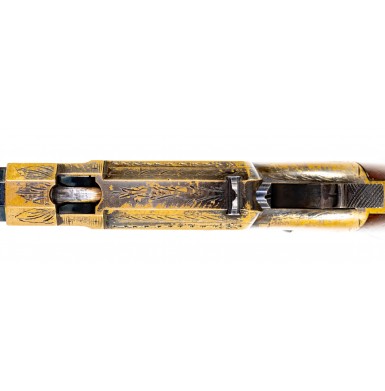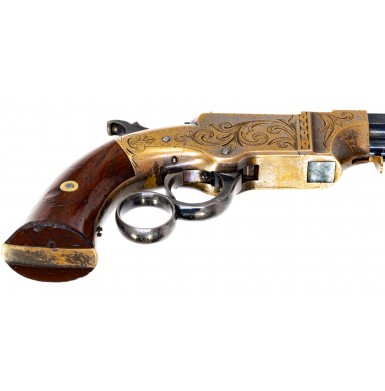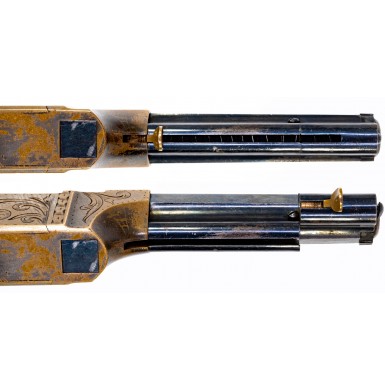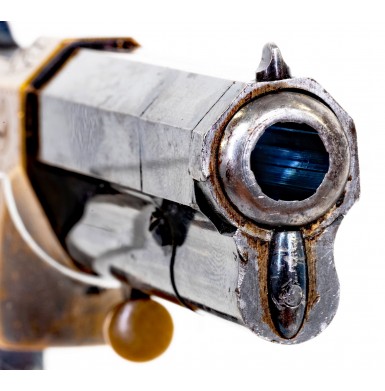Exceptional Factory Engraved New Haven Arms Company No.1 "Volcanic" Pocket Pistol
- Product Code: FHG-3529
- Availability: In Stock
-
$23,900.00
The guns produced by the New Haven Arms Company are some of the most historic and important weapons in the history of the development of modern repeating firearms. The company is probably most famous for manufacturing the famous Henry Rifle, and for being the launching pad for Oliver Winchester, and his subsequent endeavor, the Winchester Repeating Arms Company.
The New Haven Arms Company was built from the wreckage of the failed Volcanic Repeating Arms Company. Volcanic had been formed in July of 1855 as a joint stock company by Horace Smith, Daniel Wesson, and Courtland Palmer, with a number of investors, including Oliver Winchester, a shirt manufacturer from New Haven, CT. The Volcanic Company had been built upon an earlier failure, the original Smith & Wesson partnership. In both cases, Smith & Wesson and Volcanic, the goal of the companies was to manufacture and sell repeating firearms based upon the designs and patents of Walter Hunt and Lewis Jennings. Hunt had developed the “Rocket Ball” ammunition, which was a crude predecessor to modern self-contained fixed ammunition. The “Rocket Ball” combined the primer and propellant in the recessed cavity of a conventional lead bullet, instead of the traditional system of loading, in which all the components were loaded separately. While Hunt’s “Rocket Ball” was underpowered and somewhat unreliable, it was the first somewhat successful American attempt to create a self-contained cartridge that was potentially useable in a repeating firearm. Hunt subsequently patented a crude repeating rifle design that utilized his ammunition. Hunt’s design was further improved upon by Lewis Jennings. Jennings modified and refined it, with the result being the Volition repeating rifle. As none of the designers had the capital or manufacturing capability to proceed with the venture, the patents were assigned to George Arrowsmith, who found the same difficulties, and subsequently sold the patent rights to Courtland Palmer. Palmer was a successful New York hardware merchant and budding industrialist. In 1850 Palmer contracted with Robbins and Lawrence of Windsor, Vermont to manufacture Jennings’s patent rifles using Hunt’s patent ammunition. It was there that the stars aligned, and a group of men that would revolutionize the firearms industry came to work together on the same project.
These luminaries of the mid-19th century Americans firearms industry were Horace Smith, Daniel Wesson, and B. Tyler Henry. All three worked on the Jennings rifle project at Robbins & Lawrence and started to come up with improvements and refinements to the design. The group realized that the single biggest issue with the Jennings design was the shortcomings in the ammunition, so the group went to work on that problem. They also set their minds to developing what would become the basic design for modern lever action firearms more than the next two decades. This resulted in the Smith-Jennings rifle, but its complicated action and underpowered Hunt patent ammunition kept the design from being a commercial success. In 1852, at the completion of the contract with Robbins & Lawrence, Palmer left the endeavor. However, he appears to have remained in contact with Smith and Wesson. Over the next two years Smith and Wesson worked on improving the ammunition and the firearm designs. Their improvements received patents in 1854 for a new, improved ammunition design and for a repeating firearm with a toggle link action, the basis for all the Volcanic, Henry and early Winchester firearms designs.
In 1854, with Courtland as their financier and the holder of the Jennings and Hunt patents, the first incarnation of Smith & Wesson was born. The firm lasted for only a year, but produced the first of the lever action, toggle link firearms that would revolutionize the American arms industry. Some 1,700 guns were produced between 1854 and 1855. The models included a small frame .31 pistol, a larger frame .41 pistol and a handful of .50 caliber rifles. The repeating guns received the nickname “Volcanics” from a review of the arms in the magazine Scientific American, which noted the rate of fire from the guns was like the eruption of a volcano. As with their previous ventures, the shortcoming in the design was the Hunt based ammunition that they chose to use. Smith & Wesson did not use their patented ammunition in the guns, but only an improved Hunt “Rocket Ball” design. The company soon fell on hard times and Smith & Wesson sold the company assets to an investment group that included (among others) Oliver Winchester, although they stayed on to work with the company. This group set up the Volcanic Repeating Arms Company in 1855. The group produced lever action pistols in .41 caliber, as well as lever action pistol carbines with 16” barrels and detachable shoulder stocks, and conventional style lever action carbines with 16”, 20” and 24” barrels.
In 1857 the Volcanic Repeating Arms Company declared “insolvency” and went out of business. At this point, Smith & Wesson went off to pursue their own careers, and soon patented their self-contained rimfire metallic cartridge. With the purchase of Rollin White’s “bored through” cylinder patent, the pair were soon producing the revolutionary Smith & Wesson Model No. 1 revolver. The remaining assets of the Volcanic company were assigned to Oliver Winchester, and he formed the New Haven Arms Company on May 1, 1857. One of Winchester’s first moves was to hire B. Tyler Henry to be the manager for the factory. Henry was a brilliant and innovative designer and machinist and probably contributed as much to modern lever action rifle designs as later firearms genius John Browning. Under Winchester’s leadership and with Henry running the factory and workforce, the design of the lever action firearm came into its own. The company produced two frame sizes, the No. 1 in .31 caliber and the No. 2 in .41 caliber. The No.1 was manufactured as a 4” pocket pistol and a 6” target pistol, and the No. 2 was produced as a 6” or 8” “Navy” pistol, as well as a carbine with a 16”, 20” or 24” barrel. All of the guns were available with either a plain, polished brass frame or with a silver plated and engraved frame. The plating and engraving cost an extra $1.50 on the No. 1 pistols and $2.00 on the No. 2 pistols, with the carbines costing between $2.00 and $3.00 more than their unadorned brethren. Over the next few years, some 3,370 pistols and carbines would be manufactured by the New Haven Arms Company. The guns were serial numbered from 1 upwards, in sequence of manufacture, without regard to model. Thus a 4” pocket pistol could be #32 and a 16” carbine could be #33, and so on. The New Haven Arms Company also introduced the Henry Rifle in .44 Rimfire Henry Flat in 1860. The “Henry”, both the gun and the ammunition, was the result of B. Tyler Henry’s constant efforts to improve upon the basic Volcanic gun designs and Hunt’s ammunition designs. The success of the Henry rifle and its subsequent improvements led to the development of the classic Model 1866 “Yellowboy” rifle, and in 1867, the New Haven Arms Company ceased to exist, and was replaced by one of the most famous firearms companies in history, the Winchester Repeating Arms Company.
Between 1857 and 1862, some 850 New Haven Arms Company No. 1 “Volcanic” Pocket Pistols were manufactured. Due to the success of the name, and no doubt due to how well it worked in advertising and publicity, Winchester continued to market the guns as “Volcanic” pistols, even though that company was defunct. The pistols were advertised as having 4” barrels, but in reality, the octagonal barrel was just over 3 ½”, measuring between about 3 9/16” and 3 11/16” in length from the breech face to the muzzle. Like all Volcanic designs, it was a toggle link, lever action gun. Lowering the lever under the receiver to its “open” position pushed the bolt back against the hammer spur. This action cocked the hammer and raised the cartridge lifter. Pulling the lever back to its “closed” position closed the bolt and shoved the fresh cartridge from the lifter into the breech. It also returned the lifter to its resting position at the bottom of the receiver, where it was aligned with the magazine tube and would receive a fresh cartridge. The magazine tube under the barrel was spring-loaded and held six cartridges, while the magazine for the longer barreled 6” target pistol held ten. A brass follower pushed the cartridges from the muzzle towards the receiver and the cartridge lifter. To load the pistol, the follower was pulled towards the muzzle, until it had passed a split in the magazine tube. The front 1” section of the tube could then be rotated about 45-degrees to the right, exposing the magazine tube for loading, or unloading. After inserting the cartridges, the front portion of the magazine was rotated back to the closed position and the follower was released. This system fed the improved Hunt’s patent “Rocket Ball” ammunition onto the cartridge lifter to allow the pistol to function. The standard version of the No. 1 Pocket Pistol sold for $12.00 with a polished brass frame, blued barrel and magazine, case hardened hammer and lever and two-piece wood grips. For an extra $1.50, the pistol could be had with a silver plated and engraved frame. Special order grips, such as ivory, were also available for an extra charge. To put that price in perspective, during much of the American Civil War a Union private was paid $13 per month, so these revolutionary guns cost nearly as much as a month’s wages for a typical laborer of the period.
This is example of a New Haven Firearms No. 1 Pocket “Volcanic” Pistol is in NEAR EXCELLENT condition. The gun is one that originally sold for $13.50 as it features a hand engraved brass frame that was silver plated as well. This pistol is serial number 2013 and is so marked on the left side of the grip frame, under the grips, and on the interior of both grip panels. The pistol was not further disassembled to look for other numbers, as the condition of the gun indicates that it clearly “grew up together” as a long-time collector friend of mine used to say. This number makes this a mid-production pistol, placing it in the middle third of New Haven Arms “Volcanic” firearms production, and suggesting that it was probably manufactured circa 1860 or so, on the eve of the American Civil War. The pistol appears to be 100% complete and correct in every way. It remains in very crisp and sharp condition throughout. The pistol retains about 80%+ of its original bright blue on the barrel and magazine, with most of the loss apparently due to flaking. The right side of the barrel and magazine retains somewhat more of the blue than the left side of the barrel, with the proportions roughly 90%+ on the right and 70%+ on the left, with left side also showing a few minor surface scuffs and minor finish scratches. The areas where the finish has worn or flaked have developed a dull bluish-gray patina. There are also some lightly scattered freckles of minor surface oxidation present here and there on the barrel and magazine tube. The top of the barrel is clearly marked in a single line:
NEW HAVEN CONN. PATENT FEB 14, 1854.
The magazine tube retains its original brass follower and what appears to be the original magazine spring is in place. The follower moves smoothly and the spring retains good tension. The front of the magazine tube rotates smoothly and opens and closes as it should, with no undue stress or strain. The bore of the .31 pistol is in FINE condition and remains mostly bright, with strong rifling and only some lightly scattered oxidation along its length. The fire blued operating lever retains about 50%+ of its bright blue finish, with the loss apparently being from flaking and from handling. The exposed metal on the lever has a mostly smooth smoky gray patina with scattered areas of darker age discoloration and light surface oxidation. The bottom of the cartridge lifter retains about 85%+ of its original bright fire blued finish, with two patches of finish loss that appear to be from wear. The top of the lifter retains a similar amount of fire blue, with the loss along the high edges apparently due to wear as well. The rear sight retains at least 85% of its fire blue, with high edge and contact point wear, leaving a silvery patina on the exposed metal. The hammer still retains about 80%+ of its casehardened colors in terms of coverage, but has a dull, muted appearance with little vibrance or mottling present. The majority of loss is along the lower edge of the body where motion has worn the finish away, leaving a dull pewter gray patina. The frame retains about 20%+ of the original silver plating which has thinned and oxidized to a tarnished dark silvery gray. The plating is primarily found in the protected areas of the frame with the balance of the brass having a rich butterscotch patina that is extremely attractive. The frame is engraved with lovely loose Arabesque foliate scrolls that cover the majority of the frame sides and top. Geometric patterns separate the main portion of the frame from the front portion where the chamber and barrel junction are, with simple decorative scrolls at the grip junction, dashed line borders around the periphery of the frame and simple thistle patterns along the backstrap. All of the engraving remains crisp and sharp and fully visible. The two-piece smooth varnished walnut grips are in VERY FINE+ condition. They are free of any breaks, cracks, or repairs and remain solid and complete. The grips retain about 80%+ of their original varnished finished, and other than some scattered handling bumps and dings, remain very crisp and sharp. The fit of the grips to the frame is excellent, and as mentioned above, both grip panels are numbered to the pistol on their interior. There are some old, very small chips and dings along the periphery of the sharp edges of the grips at their base, but otherwise the grips show no significant damage or wear that is inconsistent with the overall condition of the pistol.
The action of the pistol works perfectly and is mechanically excellent. The ring lever operates smoothly, the cartridge lifter raises and lowers as it should and the hammer cocks crisply and releases when the trigger is pulled. While a common misconception about these guns implies that they operate like a lever action rifle, with the cocking action performed by operating the lever, the reality is that the handguns were intended to be manually cocked before the lever was operated to raise and lower the cartridge lifter. The short length of the lever and its short throw do not provide enough force to allow the tension of the mainspring to be overcome and cock the hammer. The pistol retains its original blade front sight on the top of the octagon barrel, near the muzzle, and the original notched rear sight, dovetailed into the top of the brass frame. Even the screws of the pistol remain in very crisp condition, showing practically no slot wear or abuse.
Overall, this is a really outstanding condition example of a factory engraved, untouched and original example of a New Haven Arms No. 1 Pocket “Volcanic” Pocket Pistol. The gun has exceptional eye appeal and is really in outstanding condition. With only 850 of these little pistols produced, these can be difficult guns to find for sale, particularly in such lovely shape. This would be a great addition to any collection of Civil War era pistols and is an essential bookend to a collection of 19thcentury American cartridge pistols. Many of these little guns went off to battle in the early days of the American Civil War in the pockets of young soldiers and officers, and this gun would be equally at home in a collection that represents the many early weapons that went to war from home. One way or another, this is a scare and desirable pistol that was the direct predecessor to the famous Henry Rifle and deserves a place in a collection of fine antique arms. This is also a gun that would be nearly impossible to upgrade and is no doubt one that will give you many years of enjoyment in your collection.
Tags: Exceptional, Factory, Engraved, New, Haven, Arms, Company, No1, Volcanic, Pocket, Pistol

